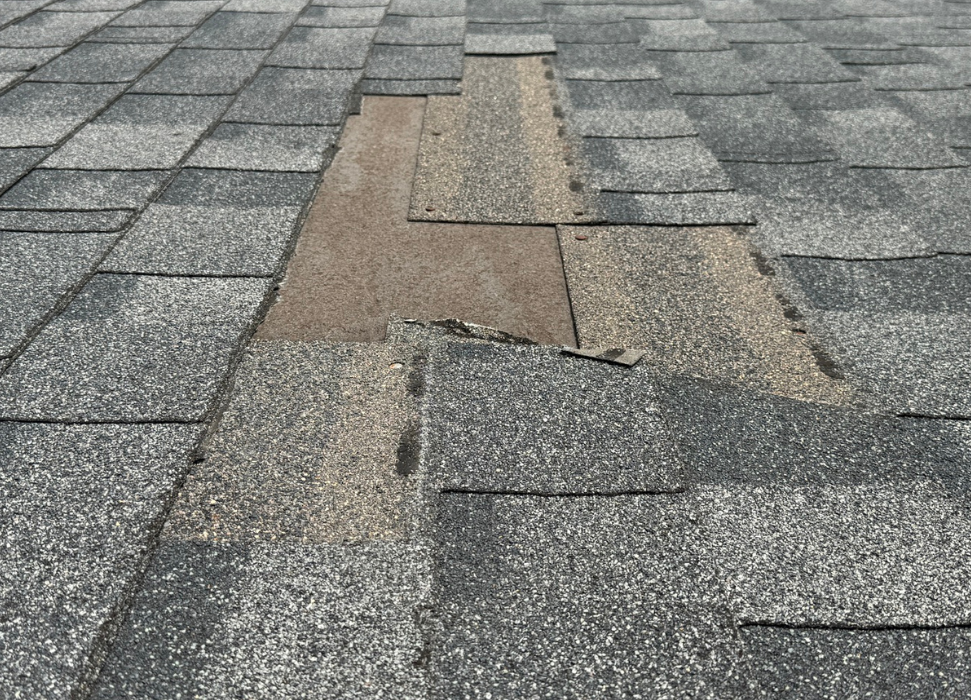After a heavy storm, most of us are just glad to see clear skies again. But as the clouds roll away and the sun returns, your roof may be hiding signs of damage caused by those strong winds that could worsen quickly if left unchecked.
Over the last decade, severe weather events have caused over $1 trillion in property damage across the U.S., and wind damage to roofs has become one of the most common and costly issues for homeowners. While it may not be as visible as a fallen tree or a flooded basement, roof damage from high winds is often silent and sneaky, until it becomes a bigger (and more expensive) problem.
Knowing how to inspect your roof for wind damage can save you money, reduce the risk of more severe structural issues, and help you take the right steps toward a timely roof repair or roof replacement if needed.
Why Wind Damage Happens—and Why You Might Not Notice
Strong winds don’t have to reach tornado strength to cause serious problems. In fact, winds as low as 45 mph can lift, loosen, or tear off shingles, especially if your roof is already aging or wasn’t installed properly.
Unlike hail damage, which tends to leave behind obvious dents or divots, wind damage can be harder to detect from the ground. Missing shingles are easy to spot, but curled or lifted edges might go unnoticed unless you’re specifically looking for them. Worse, damage beneath the surface—like torn underlayment or weakened flashing—can allow water to seep in, causing interior damage that might not show up for weeks or months.
Signs Your Roof May Be Damaged After a Windstorm
The first thing to do after a storm is a visual inspection from the ground. Walk around your home and check for anything that looks out of place. Are there shingles lying in your yard? Are any hanging off the edges of your roof? Does anything look uneven or sagging? These could all be signs that something is wrong.
Beyond the obvious, wind damage can present in more subtle ways. You might notice sections of your gutters pulling away from the fascia, or flashing that has come loose around chimneys, skylights, or vents. Granules from asphalt shingles might appear in your downspouts or at the base of your gutters—an early sign that your shingles are deteriorating.
Inside your home, take a look at the ceilings and attic space. Damp insulation, water stains, or a musty odor can indicate that water has made its way in through damaged areas. These kinds of warning signs often point to more serious structural issues that will require either an in-depth roof repair or, in some cases, a complete roof replacement.
Why Timing Matters When It Comes to Roof Repair
Even minor damage can become a major headache if it isn’t addressed quickly. That one missing shingle you spotted in the yard? It could be the reason your attic is leaking the next time it rains. And that curled shingle at the edge of the roof? It might be the spot where wind will grab and rip off a whole section the next time a storm rolls through.
Roofing issues caused by wind tend to compound. Water intrusion leads to mold, rot, insulation damage, and even electrical hazards. The longer the damage is ignored, the more extensive the repairs become. That’s why it’s always a good idea to schedule a roof inspection as soon as possible after a windstorm, especially if your roof is over 10 years old or you’ve already had repair work done in the past.
Roof Damage and Insurance: What You Need to Know
If your roof has been damaged in a storm, your homeowners insurance may cover the cost of roof repair or replacement. But insurance adjusters will be looking for specific signs of wind damage, and they won’t always catch everything. That’s why it’s smart to have a licensed roofing professional inspect the roof first.
A reputable roofer will know what evidence to document, what damage insurance companies require to approve a claim, and how to help you navigate the claims process. From photos and inspection reports to working directly with your adjuster, your roofer can make the difference between a partial repair and full coverage.
Waiting too long to report damage can also put your claim at risk. Many policies have time limits for filing storm-related claims, and if an adjuster believes damage came from neglect rather than a specific event, coverage may be denied. That’s why it’s so important to act quickly—and why even minor damage deserves your attention.
When Is It Time for a Roof Replacement?
Not all wind damage means you’ll need a new roof, but sometimes, it’s the most practical and cost-effective solution. If your roof has widespread shingle loss, recurring leaks, or is more than 15–20 years old, a roof replacement may offer better long-term value than piecemeal repairs.
The good news? A new roof isn’t just about protection—it’s also an opportunity to upgrade energy efficiency, reduce maintenance headaches, and improve curb appeal. If your insurance is covering the damage, you may even be able to explore upgraded materials or colors without shouldering the full cost.
Don’t Wait Until It’s Too Late
After a windstorm, it’s easy to assume that no visible damage means no problems. But when it comes to your roof, appearances can be deceiving. Even small issues can lead to major repairs if they’re left unchecked. That’s why knowing how to spot roof damage and taking quick action is so important.
If you’ve recently experienced high winds in your area and suspect something might be wrong, call a trusted roofing contractor to schedule an inspection. Whether you need a simple roof repair or a full roof replacement, addressing the damage early can save you money, stress, and future headaches.
Your roof is your home’s first line of defense. Take care of it, and it’ll take care of everything underneath.


